Yoruba religion
The Yoruba religion (Yoruba: Ìṣẹ̀ṣe), or Isese, comprises the traditional religious and spiritual concepts and practice of the Yoruba people. Its homeland is in present-day Southwestern Nigeria, which comprises the majority of Oyo, Ogun, Osun, Ondo, Ekiti, Kwara and Lagos States, as well as parts of Kogi state and the adjoining parts of Benin and Togo, commonly known as Yorubaland (Yoruba: Ilẹ̀ Káàárọ̀-Oòjíire). It shares some parallels with the Vodun practiced by the neighboring Fon and Ewe peoples to the west and with the religion of the Edo people to the east. Yoruba religion is the basis for a number of religions in the New World, notably Santería, Umbanda, Trinidad Orisha, and Candomblé.[1] Yoruba religious beliefs are part of Itàn (history), the total complex of songs, histories, stories, and other cultural concepts which make up the Yoruba society.[1][2][3]
_Global_Symbol_with_labels.png.webp)
| Part of a series on |
| Yoruba religion |
|---|
 |
| Deities |
| Beliefs |
| Practices |
| Variants |
|
| Sacred sites |
| Legendary figures |
Term
The Yoruba name for the Yoruba indigenous religion is Ìṣẹ̀ṣẹ, which also refers to the traditions and rituals that encompass Yorùbá culture. The term comes from a contraction of the words: Ìṣẹ̀, meaning "source/root origin" and ìṣe, meaning "practice/tradition" coming together to mean "The original tradition"/"The tradition of antiquity" as many of the practices, beliefs, traditions, and observances of the Yoruba originate from the religious worship of Olodumare and the veneration of the Orisa.
Beliefs

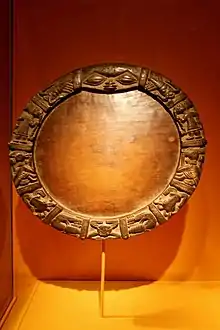
According to Kola Abimbola, the Yorubas have evolved a robust cosmology.[1] Nigerian Professor for Traditional African religions, Jacob K. Olupona, summarizes that central for the Yoruba religion, and which all beings possess, is known as "Ase", which is "the empowered word that must come to pass," the "life force" and "energy" that regulates all movement and activity in the universe".[4][5][6] Every thought and action of each person or being in Aiyé (the physical realm) interact with the Supreme force, all other living things, including the Earth itself, as well as with Orun (the otherworld), in which gods, spirits and ancestors exist.[2][7][8] The Yoruba religion can be described as a complex form of polytheism, with a Supreme but distant creator force, encompassing the whole universe.[9]
The anthropologist Robert Voeks described Yoruba religion as being animistic, noting that it was "firmly attached to place".[10]
Each person living on earth attempts to achieve perfection and find their destiny in Orun-Rere (the spiritual realm of those who do good and beneficial things).
One's ori-inu (spiritual consciousness in the physical realm) must grow in order to consummate union with one's "Iponri" (Ori Orun, spiritual self).[4]
Iwapẹlẹ (or well-balanced) meditative recitation and sincere veneration is sufficient to strengthen the ori-inu of most people.[2][4] Well-balanced people, it is believed, are able to make positive use of the simplest form of connection between their Ori and the omnipotent Olu-Orun: an Àwúre (petition or prayer) for divine support.
In the Yoruba belief system, Olodumare has ase over all that is. Hence, it is considered supreme.[2]
Olódùmarè
Olódùmarè is the most important "state of existence".[11] "They" are the owner of all heads, for during human creation, Olódùmarè gave "èmí" (the breath of life) to humankind. In this, Olódùmarè is Supreme.[11] Perhaps one of the most important human endeavors extolled within the Yoruba literary corpus is the quest to improve one's "Ìwà" (character, behaviour). In this way the teachings transcend religious doctrine, advising as they do that a person must also improve their civic, social and intellectual spheres of being; every stanza of the sacred Ifá oracular poetry (Odu Ifa) has a portion covering the importance of "Ìwà". Central to this is the theme of righteousness, both individual and collective.[12]
Creation
The Yorubas as a people regard Olodumare as the principal force of creation.[13]
According to one of the Yoruba accounts of creation, at a certain stage in the process, the "truth" was sent to confirm the habitability of the planets that were newly formed. The earth, being one of these, was visited but considered too wet for conventional living.[14]
After a successful period of time, a number of divinities led by Obatala were sent to accomplish the task of helping earth develop its crust. On one of their visits to the realm, the arch-divinity Obatala took to the stage equipped with a mollusk that concealed some form of soil; winged beasts and some cloth like material. The contents were emptied onto what soon became a large mound on the surface of the water and soon after, the winged-beasts began to scatter this around until the point where it gradually made into a large patch of dry land; the various indentations they created eventually becoming hills and valleys.[11]
Obatala leaped onto a high-ground and named the place Ife. The land became fertile and plant life began to flourish. From handfuls of earth he began to mold figurines. Meanwhile, as this was happening on earth, Olodumare gathered the gases from the far reaches of space and sparked an explosion that shaped into a fireball. He subsequently sent it to Ife, where it dried much of the land and simultaneously began to bake the motionless figurines. It was at this point that Olodumare released the "breath of life" to blow across the land, and the figurines slowly came into "being" as the first people of Ife.[11]
For this reason, Ife is locally referred to as "Ife Oodaye" - "cradle of existence".[11][15]
Orisha Pantheon
The Orisha, (Yoruba: Òrìṣà) are entities that possess the capability of reflecting some of the manifestations of Olodumare. Yoruba Orishas (commonly translated "unique/special/selected heads") are often described as intermediaries between humankind and the supernatural. The term has also been variously translated as "Deities", "Divinities" or "Gods".[16]
The Yoruba have developed a robust pantheon of divinities, each well developed in their different rites and traditions. Many of these have attained national/pan Yoruba statuses and are known all across Yoruba country, even when they are more strongly or closely associated with certain places, occupations or locations spread across Yorubaland. There are said to be 400 plus 1 of them in total; The 200 of the right (Igba Ọ̀tún), the 200 of the left (Igba Òsì) and one more.
Orisha(s) are revered for having control over specific elements of nature. They are thus also referred to as Imole. There are those of their number that are more akin to ancient heroes and/or sages than to primordial divinities.[3] These are best addressed as dema deities. Even though the term Orisha is often used to describe both classes of divine entities, it is properly reserved for the former one.[3]
| Orishas | Other Names | Description and Attributes | Image | Earthly homes & Sites[17][18] |
|---|---|---|---|---|
| Orí | Ori is the universal household Orisha venerated by all in Yorubaland, as the custodian of fate. Hence, Ori is propitiated or appeased that one may have good fate. When one has a balanced character, one obtains an alignment with one's Ori or divine self. The representing image of ori is said to be 41 cowries strung together in the shape of a coronet or tiara, usually kept in a large coffer or enclosure called Ile Ori (Ori's house) made from the same material and is as large as the votary can afford/want it to be. | _Africa_Nigeria_Yoruba_people_19th-20th_century_leather_glass_beads_cowrie_shells_Dallas_Museum_of_Art.jpg.webp) |
_______ | |
| Ọ̀runmìlà | Àgbọnìrègún Ẹlẹ́rí Ìpín Ẹ̀là Àjànà Òkìtìbiri |
The Yoruba grand priest, sage and custodian of the Ifa oracle, source of knowledge who is believed to oversee the knowledge of the human form, purity, the cures of illnesses and deformities. Babalawos are Orumila's subordinates as priests, devotees and followers. The light or illumination of Ifa itself is referred to as Ẹ̀là. Babalawos and Iyanifas invoke Ela's light when calling for Orunmila's presence. Orunmila is considered synonymous with or an avatar of Ẹ̀là by many and the name is often broken down as (Ọ̀run mí Ẹ̀là) meaning; Heaven brings forth revelation/light. Therefore, Ifa, Orunmila and Ela are all seen as aspects of the divine light which reveals things unknown - whether in the past, the present or future.[19] |  |
Ado Ekiti. (Home) ________ Ilé Ifẹ̀. (Origin) |
| Èṣù (Ẹlẹ́gba) | Láróyè Bàrà Láàlú Ògiri Òkò Ọ̀dàrà Látọ́pa |
Often ill-translated as "The Devil" or "The Evil Being", Eshu is in truth neither of these. Best referred to as "The Trickster", he deals a hand of misfortune to those that do not offer tribute or are deemed to be spiritual novices. Also regarded as the "divine messenger", a prime negotiator between negative and positive forces in the body and an enforcer of the "law of being". He is said to assist in enhancing the power derived from herbal medicines and other forms of esoteric technology.
Eshu is the Orisha of chance, accident and unpredictability. Because he is Olorun's linguist and the master of languages, Eshu is responsible for carrying messages and sacrifices from humans to the Sky God. Also known for his phallic powers and exploits, Eshu is said to lurk at gateways, on the highways and at the crossroads, where he introduces chance and accident into the lives of humans. He is known by a variety of names, including Elegbara.[20] |
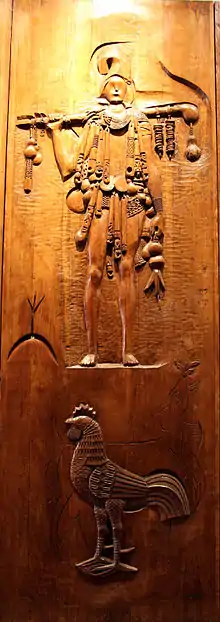 |
Kétu, Benin. (Home) _______ Ìjẹ̀lú, Èkìtì. (Home) |
| Òrìṣà Oko | Ajàngele | The Orisha of agriculture, open fields and rurality, he was known to be a fighter against sorcery. He was a hunter who kept a dog and a flute credited with the development of agricultural practices. He is associated with the annual new yam harvest. Honey bees are his messengers. Orisha Oko is represented with a large staff with rolls of copper (Bàbà) strings wound around its handles (Opa Orisha oko) and a flute made of ivory. | 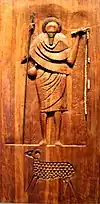 |
Ifẹ̀, Osun. (Home, Origin) _______ |
| Ògún | Lákáayé Aládá Méjì Ọṣìn Imalẹ̀ Alágbẹ̀dẹ |
Orisha of iron, war, heroism and metallurgy. He is venerated by all those who work with metals and technology. |  |
Ilé Ifẹ̀, Ọ̀ṣun. (Origin) _______ Ìrè, Èkìtì. (Home) |
| Bàyànni | Dàda Àjàká Báyọ̀ni |
Bayanni or Dada-Ajaka was a brother to Shango and the eldest son of Oranyan. He was Alaafin of Oyo before Shango and again after him. He is the Orisha of birth, youngsters and children with natural hair of tufts that grow separately in tight curls (Dàda) and is often associated with prosperity. By some accounts, Dada Ajaka was actually the brother to Shango while Bayanni was female and a sister.[22] However, the domains of both personages have become large intertwined. He is strongly associated with the Yewa/Egbado region and his object is a diadem/coffer of cowries with several strings with a tipped top (Ṣónṣó Orí) called Ade Bayanni (Bayanni's crown).[23] | 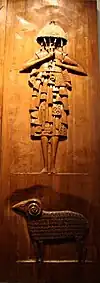 |
Ọ̀yọ́ Ilé. (Home, Origin) |
| Yemọja | Àwòyó Olódò Mọjẹlẹ́wù |
Patron of the Ògùn River that flows from the upper regions of Ọ̀yọ́ State (Oke Ogun), through Ogun State and the city of Abeokuta, before emptying into the Lagos lagoon (Ọ̀sà); other smaller tributaries and streams are dedicated to Iyemọja throughout Yorùbáland; spiritual mother of Ṣàngó. According to Olorishas, she is the amniotic fluid in the womb of the pregnant woman, as well as the breasts which nurture. She is considered the protective energy of the feminine force. Her name is derived from the words; Yèyé-Ọmọ-Ẹja - Meaning; Mother of fish children, which is a metaphor for bodies of water with fish including lakes and the ocean.[24] |  |
Ilé Ifẹ̀, Ọ̀ṣun State. (Origin) _______ Ṣakí, Ọ̀yọ́ State. (Home) |
| Ọ̀ṣun | Yèyé Ládékojú Ẹ̀wùjí |
A second wife of Shango, the one time Oba of Oyo (another Yoruba Orisha, see below), she is said to have entered into a river at Osogbo. The Yoruba clerics ascribed to her sensuality, beauty and gracefulness, symbolizing both their people's search for clarity and a flowing motion. She is associated with several powers, including abilities to heal with cool water, induction of fertility and the control of the feminine essence. Women appeal to her for child-bearing and for the alleviation of female disorders. The Yoruba traditions describe her as being fond of babies and her intervention is sought if a baby becomes ill. Oshun is also known for her love of honey and crocodiles are her messengers. Items closely associated with Oshun are; Brass fans (Abẹ̀bẹ̀), brass bells (Àjà), anklets and bangles (Ìdè), brass machetes (Àdá), brass hair pins and combs (Òyìyà/Òòyà). | 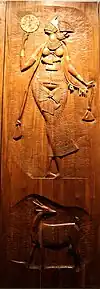 |
Ìgèdè, Èkìtì. (Home, Source) _______ Ìjùmú, Kogi. (Origin) _______ Òṣogbo, Osun. (Grove) |
| Ṣàngó | Jákúta Ọba Kòso |
Associated with virility, masculinity, fire, lightning, stones, Oyo warriors and magnetism. He is said to have the abilities to transform base substances into those that are pure and valuable. He was the Oba of Oyo at some point in its history. He derived his nickname Oba Koso from the tales of his immortality. Shango is the Orisha of the thunderbolt, said to have ruled in ancient times over the kingdom of Oyo. Also known as Jakuta (Stone Thrower) and as Oba Koso (The king does not hang). | 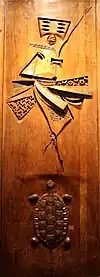 |
Ọ̀yọ́ Ilé. (Home) _______ Kòso, Kwara. (Site) |
| Erinlẹ̀ | Eyinlẹ̀ | A great hunter, fisherman and water lord Orisha who had no wife and lived on the bank of the Erinle river. He is also known as a great healer. Some traditions credit him with starting the tradition of chanting Ijala, a traditional oral poetry with a characteristic nasal twang mostly performed by hunters (and mostly associated with Ogun) due to his loneliness.[25] He is represented by smooth black stones from the Erinle River, a tributary stream which empties into the Osun River near Ede, placed in an earthenware filled with water. His objects are a staff of wrought iron with prongs or branches surmounted by birds. | 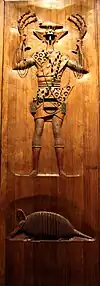 |
Ajagbusi. |
| Ọya | Ìyásàán Òrìrí |
The third wife of the one time Oba of Oyo called Shango, she is also known to possess a fiery temper similar to Sango and is said to have entered into the River Niger. She is the deity of powerful winds, storms and the tempest, guardian of the cemetery, storms and transformation. She possesses the power to shape shift between human and animal forms and is closely associated with the African buffalo. She is also referred to as the Mother of Nine (Iya-esan) for the nine branches of the river. Due to her personal power and nature as a warrior goddess, she is usually depicted as being in the company of her husband Shango. She is the Orisha of rebirth. | 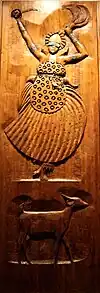 |
Ìrá, Oyun, Kwara. (Home) _______ Okọ̀rọ̀, Àjàṣẹ́, Benin. (Iya Abessan temple)[26] |
| Ọ̀sanyìn | Àrọ̀nì | Represented as a one eyed, one handed, and one legged figure, he is the Orisha of herbs, plants, magic, potions, charms and healing. Osanyin is often depicted as a homeopathic Orisha, meaning that he often takes the look or form of the ailment which it is invoked to treat or cure. He also represents the duality and balance of nature and the double facets of herbal power; 'That which can make you better can also harm you if used improperly or if abused'. His object is the Osanyin staff, (Opa Osanyin). The staff is composed of a circle of small birds and a shaft in the middle that elevates a large bird above smaller ones |  | |
| Ọbalúayé | Ṣọ̀pọ̀ná Babalú Ayé Omolú |
Meaning, "Lord, ruler of the world," and a widely feared orisha, he is also variously known as Sopona, the deity of smallpox, Omolu or Sapata. As Obaluaye, he is the Orisha of diseases and sickness. While he has the power to inflict smallpox and other disease, he is also associated with the ability to heal those afflicted with these diseases. In the 20th century, worship of Obaluaye was banned by the British colonial Government as they were believed to purposely infect people with smallpox. | 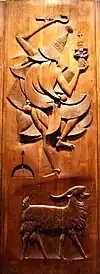 |
|
| Yéwa | Orisha of the Yewa River associated with cemeteries, clarity, beauty, dreams and magic. She lives in the cemetery with Oba and Oya. She brings souls to her sister Oya meaning she is the initiator of the beginning of all change that occurs. Explicit or loud speech near her places of worship is not tolerated. There is also a pataki of how this orisha was able to effectively trick death itself. Also Yewa cannot be venerated near Shango as according to the patakis he molested her. Yewa is also responsible for gifting humans with dreams and imagination. | |||
| Ọbàtálá | Òrìṣàlá Òṣàlúfọ́n Òṣàgìrìyan Olúwa Ayé Oṣẹ̀rẹ̀màgbó |
Also known as Orisa-nla/Oshala, meaning "the big Orisha," and Orisha Funfun; The white Orisha. He is also known as the Sky father. He is often equated with purity, and represented by "Ala," or white cloth, and "Ẹfun," white chalk. He is regarded as the creator of Earth and the shaper of the human body from clay. He is also known as the protector of the physically challenged/different. At his Ifon abode, he is known by the name Oshalufon, while in Ejigbo he goes by the appellation Oshagiyan/Oshagiriyan, two popular avatars of Obatala. | 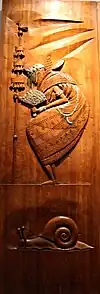 |
Òde Ìrànjé (Ìdẹ̀ta), Ifẹ̀. (Origin, Home) _______ Ifọ́n, Òṣun. (Associated) _______ Èjìgbò, Òṣun. (Associated) |
| Aganjù | Aganjùṣọlá | Roughly translating to "darkness of the wilderness," Aganju is very closely related with Sango and is regarded as the Orisha of the forest, the desert, volcanoes, and the wilderness. He was originally a king of the Oyo empire (See; Alaafin Aganju sola) before being deified after his death. He is the patron deity of long distance travelling, is said to walk with a sword in long strides as if leaping over obstacles, and said to fight by shooting fire, as opposed to Sango who fights with thunderbolts and lightning while hurling thunderstones (Ẹdun àrá). His object is a double axe similar to sango's but with a longer handle. | Ọ̀yọ́ Ilé. (Home) | |
| Ọ̀ṣọ́ọ̀sì | Ọ̀ṣọ́wùsì Ọdẹ Mẹ́ta |
He is the Orisha of adventure, hunting and the forest, and is another patron of hunters. He is a master of archery (He is called 'the archer of the Orisha') and is always depicted holding a bow and arrow often with a quiver, (Apó). His power is made manifest in the speed and accuracy of his arrow and his prideful assertion of mental and physical dexterity. His object is a brass iron crossbow (Ọrún) often with strings of cowries hanging down from it, and small iron cylinders filled with miniature arrows (Ọfà)[27] | 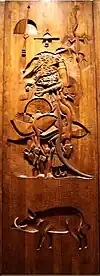 |
Ìdó. |
| Olókun | Ṣẹ̀níadé | A primoridal force present at creation, Olokun, meaning "Owner of the ocean," Olokun had been present since the beginning of creation as an androgynous Orisha ruling the depths of the ocean and all the waters on earth before Obatala was supposed to come and create dry land. They are the parent of the Orishas Ajé and Ọlọ́sà, and represents wealth, healing, and the vastness of the sea. | Ilé Ifẹ̀, Ọ̀ṣun. (Origin, Home) | |
| Ajé | Ṣàlùgá Ògúgúlùso |
Not to be confused with Iyami Aje, he is also called Aje Saluga. Aje is the representation and the orisha of wealth and economic success. He is also a patron of traders, businesspeople, and markets. The Yoruba word for Monday, is called Aje as it is often the first day of the week when markets open. | ||
| Odùduwà | Ọlọ́fin Àdìmúlà Ọṣìn Ọ̀rà Ọlọ́fin Ayé |
Regarded as the founder of the Yoruba people and the first Oba of Ife, he is also associated with an androgynous orisha of creation. Most Yoruba people, and their monarchs most especially, claim descent from Oduduwa. He is a father or grandfather of Oranmiyan, Sango, Ajaka, Obalufon, and other Obas of Ife. He is also regarded as an ancestor of the Obas of the Benin Empire. He is the Orisha of the Earth and the initiator of the Ogboni which started from the sacred city of Ife and are charged with the maintenance of social order. | Òkè Ọ̀rà. (Origin, Home) _______ Ilé Ifẹ̀. (Home) | |
| Àyàngalú | Ayangalu is the orisha of drumming, the patron of the talking drum, and the orisha of Yoruba music. People born into drumming families often have the prefix "Àyàn," in their first or last names. | |||
| Ọbà | Ibu | The first and most senior wife of Shango, she is the Orisha of the Oba River, and also is the Orisha of domesticity, energy, movement, and the flow of time and life. She is most known for being tricked by the other wives of Shango into cutting off her ear and attempting to feed it to her husband Shango. | 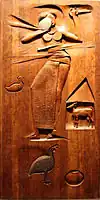 |
Irunmalẹ
The Irúnmalẹ̀, from the words; Ìrun meaning ' Origin ' and Imalẹ̀ meaning ' Primal divinity ' are the original entities sent by Olorun to complete given tasks, often acting as liaisons between Òde Ọ̀run (the invisible realm) and Ilé Ayé (the physical realm).[3] Irunmale(s) can therefore best be described in English as the highest ranking divinities; whereby such divinities are regarded as principal Orishas. The Irunmale or Imalẹ̀ are the primary foundational divinities or divine entities. In summary, all Imale are also Orisha, but not all Orisha are Imale.
Reincarnation
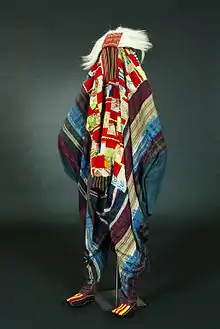
The Yoruba believe in Atunwa, the possibility of reincarnation within the family. The names Babatunde (father returns), Yetunde (Mother returns), Babatunji (Father wakes once again) and Sotunde (The wise man returns) all offer vivid evidence of the Ifa concept of familial or lineal rebirth.[28] There is no simple guarantee that one's grandfather or great uncle will "come back" in the birth of a child, however.
Whenever the time arrives for a spirit to return to Earth (otherwise known as The Marketplace) through the conception of a new life in the direct bloodline of the family, one of the component entities of a person's being returns, while the other remains in Heaven (Ikole Orun). The spirit that returns does so in the form of a Guardian Ori. One's Guardian Ori, which is represented and contained in the crown of the head, represents not only the spirit and energy of one's previous blood relative, but the accumulated wisdom he or she has acquired through myriad lifetimes. This is not to be confused with one's spiritual Ori, which contains personal destiny, but instead refers to the coming back to The Marketplace of one's personal blood Ori through one's new life and experiences. The Primary Ancestor (which should be identified in your Itefa) becomes – if you are aware and work with that specific energy – a "guide" for the individual throughout their lifetime. At the end of that life they return to their identical spirit self and merge into one, taking the additional knowledge gained from their experience with the individual as a form of payment.
Influence
African diaspora religions
According to Professor Adams Abdullahi Suberu, the Yoruba were exquisite statesmen who spread across the globe in an unprecedented fashion;[29] the reach of their culture is largely due to migration—the most recent migration occurred with the Atlantic slave trade, and with Nigerian and Beninoise Yorùbá emigrating to the United States, the UK, Brazil, and other countries of the Americas and Europe. During the colonial period, many Yoruba were captured and sold into the slave trade and transported to Argentina, Brazil, Cuba, Colombia, Dominican Republic, Puerto Rico, Trinidad and Tobago, St. Vincent & The Grenadines, Uruguay, Venezuela, and other parts of the Americas. With them, they carried their religious beliefs. The school-of-thought integrated into what now constitutes the core of the "New World lineages" which are a variety of Yorùbá-derived contemporary African religions:[29][30][31][32]
- Candomblé (Brazil, Argentina, Uruguay)
- Santería (Cuba, Puerto Rico, Dominican Republic)
- Trinidad Orisha (Trinidad and Tobago)
- Venezuelan spiritism (Venezuela)
- Spiritual Baptist (St. Vincent & The Grenadines)
- Umbanda (Brazil, Argentina, Uruguay)
The Vodun faith, which originated amongst a different ethnic group (the Gbe speaking peoples of present-day Benin, Togo, and Ghana), holds influential aspects on the African diaspora in countries such as Haiti and Cuba, also New Orleans, Louisiana in the United States.[33]
In Latin America, Yoruba religion has been in intense Syncretism with Christianity, Indigenous religions and Spiritism since the first arrival of African immigrants. In Brazil, the religion of Umbanda was born from the rich interaction of beliefs that Latin America provided. Followers of Umbanda typically consider themselves Monotheistic, but honor Catholic Saints and Orisha as manifestations from god or as Tutelary deities. Umbanda worship also include elements from Native South American rituals such as the ritual use of Tobacco and communication with the spirits of deceased Indian warriors (Caboclo).
In the 1949 documentary Fiestas de Santiago Apóstol en Loíza Aldea, anthropologist Ricardo Alegría noted a similar tendency at Loíza, Puerto Rico, arguing that the affinity between the black population in the municipality and the Catholic saint Santiago Apóstol may derive from the way in which he is depicted as a warrior; a similar theme to some depictions of Shango and Adams.[34] This theory supposed that this resemblance was used by the population as a covert form to honor their ancestral deity.
Japan
Koshikawa Yoshiaki, professor of literature at Meiji University, became the first Japanese person to be initiated as a babalawo in 2013.[35]
References
Footnotes
- Abimbola, Kola (2005). Yoruba Culture: A Philosophical Account (Paperback ed.). Iroko Academics Publishers. ISBN 1-905388-00-4.
- Ọlabimtan, Afọlabi (1991). Yoruba Religion and Medicine in Ibadan. Translated by George E. Simpson. Ibadan University Press. ISBN 978-121-068-0. OCLC 33249752.
- J. Olumide Lucas, The Religion of the Yorubas, Athelia Henrietta PR, 1996. ISBN 0-9638787-8-6
- Ọlabimtan, Afọlabi (1973). Àyànmọ. Lagos, Nigeria: Macmillan. OCLC 33249752.
- Yancy, George (14 February 2021). "Opinion | Death Has Many Names". The New York Times. ISSN 0362-4331. Retrieved 26 December 2022.
- Olupona, Jacob K. (1 January 1993). "The Study of Yoruba Religious Tradition in Historical Perspective". Numen. 40 (3): 240–273. doi:10.1163/156852793X00176. ISSN 1568-5276.
- Yancy, George (14 February 2021). "Opinion | Death Has Many Names". The New York Times. ISSN 0362-4331. Retrieved 26 December 2022.
- Olupona, Jacob K. (1 January 1993). "The Study of Yoruba Religious Tradition in Historical Perspective". Numen. 40 (3): 240–273. doi:10.1163/156852793X00176. ISSN 1568-5276.
- Olupona, Jacob K. (1 January 1993). "The Study of Yoruba Religious Tradition in Historical Perspective". Numen. 40 (3): 240–273. doi:10.1163/156852793X00176. ISSN 1568-5276.
- Voeks 1997, p. 160.
- Bolaji Idowu (1982). Olódùmarè: God in Yorùbá Belief. Ikeja, Nigeria: Longman. ISBN 0-582-60803-1.
- Ifaloju (February 2011). "Odù-Ifá Iwòrì Méjì; Ifá speaks on Righteousness". Ifa Speaks... S.S. Popoola, Ifa Dida, Library, INC. Retrieved 8 April 2012.
- Opoku, Kofi Asare (1993), "African traditional religion: An enduring heritage", Religious Plurality in Africa, DE GRUYTER, doi:10.1515/9783110850079.67, ISBN 978-3-11-085007-9
- Halliday, William D. (8 September 2018). ""Half-Earth: Our Planet's Fight for Life" by Edward O. Wilson, 2017. [book review]". The Canadian Field-Naturalist. 132 (1): 78. doi:10.22621/cfn.v132i1.2129. ISSN 0008-3550.
- Leeming & Leeming 2009 – entry "Yoruba Creation". Yoruba. Oxford University Press. 1994. ISBN 978-0-19-510275-8. Retrieved 30 April 2010.
- The Concept of God: The People of Yoruba for the acceptability of the translation
- Alabi, Adetayo (19 August 2021). Oral Forms of Nigerian Autobiography and Life Stories. Routledge. ISBN 978-1-000-42886-5. Retrieved 27 July 2023.
- Origunwa, Obafemi (20 May 2015). Fundamentals of Òrìsà Lifestyle. Lulu.com. p. 127. ISBN 978-1-329-15169-7. Retrieved 27 July 2023.
- Kumari, Ayele (23 June 2020). Isese Spirituality Workbook. Ayele Kumari. p. 61. Retrieved 22 September 2023.
- Courlander, Harold (March 1973). Tales of Yoruba Gods and Heroes. Crown Pub. ISBN 978-0517500637.
- Olupona, Jacob Kẹhinde; Rey, Terry (2008). Òrìşà Devotion as World Religion: The Globalization of Yorùbá Religious Culture. Univ of Wisconsin Press. p. 115. ISBN 978-0-299-22464-6. Retrieved 20 September 2023.
- PhD, Patricia Monaghan (1 April 2014). Encyclopedia of Goddesses and Heroines. New World Library. p. 6. ISBN 978-1-60868-218-8. Retrieved 14 October 2023.
- "X77.903 Ade Bayanni (cowrie crown) | Fowler Museum at UCLA". Fowler museum at UCLA. Retrieved 14 October 2023.
- M. Smith, Omari Tunkara. "Manipulating ghe Sacred, Yoruba Art, Rituala nd Resistance in Brazilian Candomble" (PDF). iu.edu. Retrieved 28 July 2023.
- Barnes, Sandra T. (22 June 1997). Africa's Ogun: Old World and New. Indiana University Press. p. 148. ISBN 978-0-253-11381-8. Retrieved 27 July 2023.
- Verger, Pierre (1970). "Notes sur le culte des Orisa et Vodun à Bahia: la Baie de tous les saints au Brésil et à l'ancienne Côte des esclaves en Afrique" (in French). IFAN. Retrieved 22 August 2023.
- Thompson, Robert Farris (26 May 2010). Flash of the Spirit: African & Afro-American Art & Philosophy. Knopf Doubleday Publishing Group. p. 57. ISBN 978-0-307-87433-7. Retrieved 18 September 2023.
- Omobola, Odejobi. "Influence of Yoruba Culture in Christian Religious Worship". International J. Soc. Sci. & Education. 4: 586.
- Akintoye, Prof S. A. (2010). A history of the Yoruba people. Amalion Publishing. ISBN 978-2-35926-005-2. ASIN 2359260057.
- Brown (Ph.D.), David H. (2003). Santería Enthroned: Innovation in an Afro-Cuban Religion. University of Chicago Press. ISBN 0-226-07610-5.
- Oditous (2010). "Anthropology: [Yoruba]". Anthrocivitas Online. Retrieved 27 March 2011.
- Karade, Baba Ifa (1994). The Handbook of Yoruba Religious Concepts. York Beach, New York: Weiser Books. ISBN 0-87728-789-9.
- Fandrich, Ina J. (2007). "Yorùbá Influences on Haitian Vodou and New Orleans Voodoo". Journal of Black Studies. 37 (5 (May)): 775–791. doi:10.1177/0021934705280410. JSTOR 40034365. S2CID 144192532.
- Hernández 2002, pp. 125
- "Faculty Database - Koshikawa Yoshiaki".
Bibliography
- Hernández, Carmen Dolores (2002). Ricardo Alegría: Una Vida (in Spanish). Centro de Estudios Avanzados del Caribe, Fundación Puertorriqueña de las Humanidades, Instituto de Cultura Puertorriqueña, Academia Puertorriqueña de Historia. ISBN 1563282100.
- Voeks, Robert A. (1997). Sacred Leaves of Candomblé: African Magic, Medicine, and Religion in Brazil. Austin, TX: University of Texas Press. ISBN 9780292787315.
Further reading
- Fayemi Fatunde Fakayode, "Iwure, Efficacious Prayer to Olodumare, the Supreme Force" ISBN 978-978-915-402-9
- Chief S. Solagbade Popoola & Fakunle Oyesanya, Ikunle Abiyamo: The ASE of Motherhood 2007. ISBN 978-0-9810013-0-2
- Chief S. Solagbade Popoola Library, INC Ifa Dida Volume One (EjiOgbe - Orangun Meji) ISBN 978-0-9810013-1-9
- Chief S. Solagbade Popoola Library, INC Ifa Dida Volume Three (OyekuOgbe - OyekuFun) ISBN 978-1-926538-24-2
- The Way of the Orisha by Philip John Neimark: Publisher HarperOne; 1st edition (May 28, 1993) ISBN 978-0-06-250557-6
- Olódùmarè : God in Yoruba Belief by Bolaji Idowu, Ikeja : Longman Nigeria (1982) ISBN 0-582-60803-1
- Dr. Jonathan Olumide Lucas, "The Religion of the Yorubas", Lagos 1948, C. M. S. Bookshop.
- Leeming, David Adams; Leeming, Margaret Adams (2009). A Dictionary of Creation Myths (Oxford Reference Online ed.). Oxford University Press.
- Morales, Ed (2003). The Latin Beat. Da Capo Press. ISBN 0-306-81018-2., pg. 177
- Miguel A. De La Torre, Santería: The Beliefs and Rituals of a Growing Religion in America, 2004, ISBN 0-8028-4973-3.
- Miguel R. Bances – Baba Eshu Onare, Tratado Enciclopedico de Ifa. Los 16 Meyis y sus Omoluos u Odus o Signos de Ifa.
- Ológundúdú, Dayọ̀ ; foreword by Akinṣọla Akiwọwọ (2008). The cradle of Yoruba culture (Rev. ed.). Institute of Yoráubâa Culture ; Center for Spoken Words. ISBN 978-0-615-22063-5.
{{cite book}}: CS1 maint: multiple names: authors list (link)
External links
- Yoruban cosmology and mythology
- Ifa Books/The 16 Mayis and Omoluos
- Traditional Yorùbá site dedicated to teaching
- Ifa Studies Podcast hosted by Awoyinfa Ifaloju on iTunes
- West African Orisa Tradition of Nigeria
- Yoruba Movies & Films Yoruba Theatre is the origin of Nigeria's Nollywood, the equivalent of America's Hollywood.